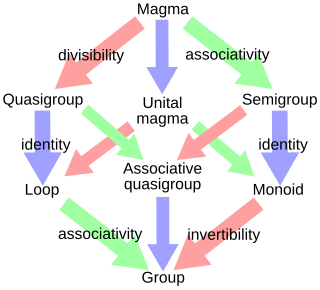
In mathematics, the Chinese remainder theorem states that if one knows the remainders of the Euclidean division of an integer n by several integers, then one can determine uniquely the remainder of the division of n by the product of these integers, under the condition that the divisors are pairwise coprime.

In mathematics, an equivalence relation is a binary relation that is reflexive, symmetric and transitive. The equipollence relation between line segments in geometry is a common example of an equivalence relation. A simpler example is equality. Any number is equal to itself (reflexive). If , then (symmetric). If and , then (transitive).

In mathematics, when the elements of some set have a notion of equivalence, then one may naturally split the set into equivalence classes. These equivalence classes are constructed so that elements and belong to the same equivalence class if, and only if, they are equivalent.

A quotient group or factor group is a mathematical group obtained by aggregating similar elements of a larger group using an equivalence relation that preserves some of the group structure. For example, the cyclic group of addition modulo n can be obtained from the group of integers under addition by identifying elements that differ by a multiple of and defining a group structure that operates on each such class as a single entity. It is part of the mathematical field known as group theory.

In mathematics, given two groups, (G,∗) and (H, ·), a group homomorphism from (G,∗) to (H, ·) is a function h : G → H such that for all u and v in G it holds that
In algebra, a homomorphism is a structure-preserving map between two algebraic structures of the same type. The word homomorphism comes from the Ancient Greek language: ὁμός meaning "same" and μορφή meaning "form" or "shape". However, the word was apparently introduced to mathematics due to a (mis)translation of German ähnlich meaning "similar" to ὁμός meaning "same". The term "homomorphism" appeared as early as 1892, when it was attributed to the German mathematician Felix Klein (1849–1925).

In mathematics, a group is a set with an operation that satisfies the following constraints: the operation is associative and has an identity element, and every element of the set has an inverse element.

In abstract algebra, a branch of mathematics, a monoid is a set equipped with an associative binary operation and an identity element. For example, the nonnegative integers with addition form a monoid, the identity element being 0.

In mathematics, modular arithmetic is a system of arithmetic for integers, where numbers "wrap around" when reaching a certain value, called the modulus. The modern approach to modular arithmetic was developed by Carl Friedrich Gauss in his book Disquisitiones Arithmeticae, published in 1801.

In abstract algebra, a normal subgroup is a subgroup that is invariant under conjugation by members of the group of which it is a part. In other words, a subgroup of the group is normal in if and only if for all and The usual notation for this relation is

In mathematics, a semigroup is an algebraic structure consisting of a set together with an associative internal binary operation on it.
In algebra, the kernel of a homomorphism is generally the inverse image of 0. An important special case is the kernel of a linear map. The kernel of a matrix, also called the null space, is the kernel of the linear map defined by the matrix.
In mathematics, specifically abstract algebra, the isomorphism theorems are theorems that describe the relationship between quotients, homomorphisms, and subobjects. Versions of the theorems exist for groups, rings, vector spaces, modules, Lie algebras, and various other algebraic structures. In universal algebra, the isomorphism theorems can be generalized to the context of algebras and congruences.

In number theory, a Gaussian integer is a complex number whose real and imaginary parts are both integers. The Gaussian integers, with ordinary addition and multiplication of complex numbers, form an integral domain, usually written as or
In ring theory, a branch of abstract algebra, a quotient ring, also known as factor ring, difference ring or residue class ring, is a construction quite similar to the quotient group in group theory and to the quotient space in linear algebra. It is a specific example of a quotient, as viewed from the general setting of universal algebra. Starting with a ring R and a two-sided ideal I in R, a new ring, the quotient ring R / I, is constructed, whose elements are the cosets of I in R subject to special + and ⋅ operations.
In mathematics, a quotient algebra is the result of partitioning the elements of an algebraic structure using a congruence relation. Quotient algebras are also called factor algebras. Here, the congruence relation must be an equivalence relation that is additionally compatible with all the operations of the algebra, in the formal sense described below. Its equivalence classes partition the elements of the given algebraic structure. The quotient algebra has these classes as its elements, and the compatibility conditions are used to give the classes an algebraic structure.
In mathematics, a congruence subgroup of a matrix group with integer entries is a subgroup defined by congruence conditions on the entries. A very simple example is the subgroup of invertible 2 × 2 integer matrices of determinant 1 in which the off-diagonal entries are even. More generally, the notion of congruence subgroup can be defined for arithmetic subgroups of algebraic groups; that is, those for which we have a notion of 'integral structure' and can define reduction maps modulo an integer.
In mathematics and computer science, the syntactic monoid of a formal language is the smallest monoid that recognizes the language .
In mathematics, Green's relations are five equivalence relations that characterise the elements of a semigroup in terms of the principal ideals they generate. The relations are named for James Alexander Green, who introduced them in a paper of 1951. John Mackintosh Howie, a prominent semigroup theorist, described this work as "so all-pervading that, on encountering a new semigroup, almost the first question one asks is 'What are the Green relations like?'". The relations are useful for understanding the nature of divisibility in a semigroup; they are also valid for groups, but in this case tell us nothing useful, because groups always have divisibility.
In mathematics, particularly in the area of arithmetic, a modular multiplicative inverse of an integer a is an integer x such that the product ax is congruent to 1 with respect to the modulus m. In the standard notation of modular arithmetic this congruence is written as














































